Eczema/Atopic Dermatitis
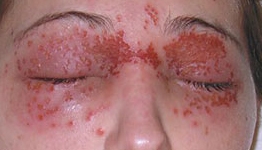
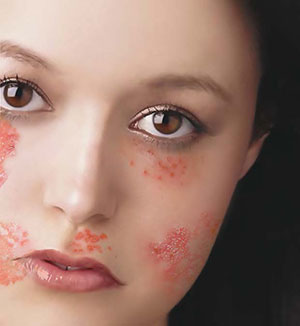
The word is used to describe all kinds of red, blistering, oozing, scaly, brownish, thickened, and itching skin conditions. Examples of eczema include dermatitis, allergic contact eczema; seborrheic eczema;and nummular eczema. This pamphlet will describe and discuss a special type of eczema that is called atopic dermatitis or atopic eczema.
Atopic Dermatitis or Atopic Eczema
The word “atopic” describes a group of allergic or associated diseases that often affect several members of a family. These families may have allergies such as hay fever and asthma but also have skin eruptions called atopic dermatitis. While most people with atopic dermatitis have family members with similar problems, 20% may be the only one in their family bothered by this problem.
Atopic dermatitis is very common in all parts of the world.It affects about ten percent of infants and three percent of the U.S. population overall.
The disease can occur at any age but is most common in infants to young adults. The skin rash is very itchy and sometimes disfiguring.
The condition usually improves in childhood or sometime
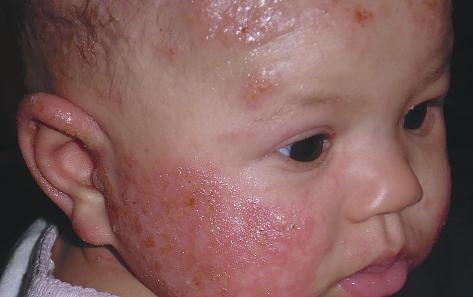
Infantile Eczema/ Atopic Dermatitis
before the age of 25. About sixty percent of patients have some degree of dermatitis and some suffer throughout life. These cases can cause frustration to both the patient and the physician.
When the disease starts in infancy, it’s sometimes called infantile eczema. This itching, oozing, crusting condition tends to occur mainly on the face and scalp, although spots can appear elsewhere. In attempts to relieve the itching, the child may rub their head and cheeks and other affected areas with a hand, a pillow, or anything within reach. Parents should know that many babies improve before two years of age.
If the disease continues or occurs beyond infancy, the skin has less tendency to be red, blistering, oozing and crusting. Instead, the lesions become dry, red to brownish-gray, and the skin may be scaly and thickened. An intense, almost unbearable itching can continue, becoming severe at night. Some patients scratch at their skin until it bleeds and crusts. When this occurs, the skin may become infected.
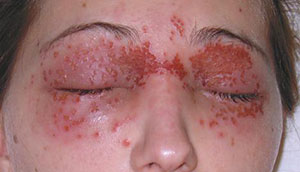
In teens and young adults, the eruptions typically occur on the elbow bends and backs of the knees, ankles and wrists and on the face, neck and upper chest. Although these are the most common sites, any body area may be affected.
Recognizing Atopic Dermatitis
An itching rash as described above, along with a family history of allergies, may indicate atopic dermatitis. Proper, early and regular treatment by a dermatologist can bring relief and also may reduce the severity and duration of the disease.
The disease does not always follow the usual pattern. It can appear on the palms or backs of the hands and fingers,or on the feet, where crusting, oozing, thickened areas may last for many years.
Questions and Answers About Atopic Dermatitis
Q. Since this condition is associated with allergies, can certain foods be the cause?
A. Yes, but only rarely (perhaps 10 percent). Although some foods may provoke attacks, especially in infants and young children, eliminating them rarely will bring about lasting improvement or a cure. If all else fails, foods such as cow’s milk, soy, eggs, fish, wheat, peanuts and other foods that are suggested by your dermatologist can be avoided at least for one to two weeks on a trial basis.
Q. Are environmental causes important, and should they be eliminated?
A. Rarely does the elimination of contact or airborne substances bring about lasting relief. Occasionally dust and dust-catching objects like feather pillows, down comforters, kapok pillows and mattresses, carpeting, drapes, some toys, and wool along with other rough fabrics, can cause the condition to worsen.
Q. Are skin tests, like those given for hay fever or asthma, of any value in finding the causes?
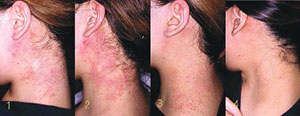
A. Sometimes, but not as a rule. A positive test signals allergy only about 20 percent of the time. If negative, the test is good evidence against allergy. If these tests are desired, ask your dermatologist to recommend someone who has experience doing them.
Q. Are “shots” such as those given for hay fever and other allergies, useful?
A. Not as a rule. They may even make the skin condition worse in some patients.
Q. What then should be done to treat this condition?
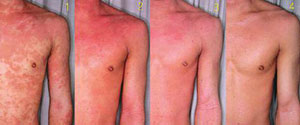
A. See your dermatologist for advice on relieving irritating factors in creams and lotions, rough, scratchy or tight clothing and woolens, rapid changes of temperature and any activity that provokes sweating. Seek advice from your dermatologist about proper bathing, and moisturizing, and dealing with emotional upsets which make the condition worse.
Your dermatologist can prescribe external medications such as corticosteroids (cortisone) creams or ointments or tar creams, and internal medications such as antihistamines to control the itching. Oral antibiotics will be prescribed if there is also a secondary infection. For severe cases, your dermatologist may recommend ultraviolet light therapy.
Internally administered cortisone should be avoided if possible. However, when other measures have failed, your physician may prescribe systemic corticosteroids (cortisone).
Atopic dermatitis is a very common condition. With proper treatment, the disease can be controlled.



